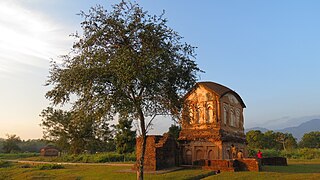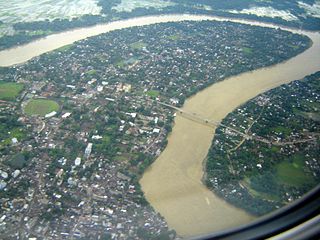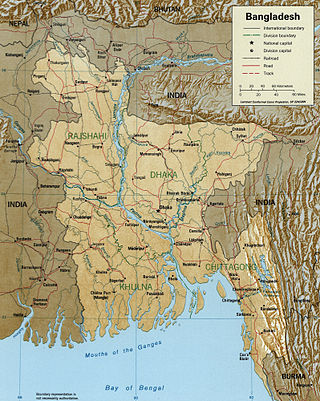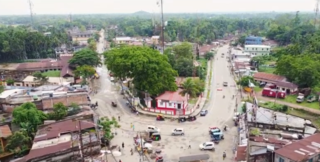Related Research Articles

Mizoram is a state in Northeast India, with Aizawl as its seat of government and capital city. The name of the state is derived from "Mizo", the self-described name of the native inhabitants, and "Ram", which in the Mizo language means "land." Thus "Mizo-ram" means "land of the Mizos". Within India's northeast region, it is the southernmost landlocked state, sharing borders with three of the Seven Sister States, namely Tripura, Assam and Manipur. The state also shares a 722-kilometre (449 mi) border with the neighbouring countries of Bangladesh and Myanmar.
Hmar, also spelled as Mar, is an ethnic group living in Northeast Indian state of Manipur and Mizoram, western Myanmar (Burma) and eastern Bangladesh.
The Hmar language belongs to the Kukish branch of the Sino-Tibetan family of languages. It is a conglomeration of the dalects of its various sub-tribes. The speakers of the language are also known as Hmar. According to the official 2011 Census of India, there are 29,268 Hmar speakers in Assam, 48,375 in Manipur, 1,700 in Meghalaya, 18,587 in Mizoram although Majority of the Hmars in Mizoram speak Duhlian (Mizo). The Census cannot be said to be truly a relaible statistic as many Hmars in Mizoram register their minority tribal status as Mizo and not Hmar. Also, as the Hmar sub-tribes in Tripura maintain their own dialects they are often not represented in these numerals.

Cachardistrict is an administrative district in the state of Assam in India. After independence, the undivided Cachar district was split into four districts in Assam: Dima Hasao district, and Cachar district alongside Hailakandi and Karimganj.

The Barak River flows 900 kilometres (560 mi) through the states of Manipur, Nagaland, Mizoram and Assam in India. Further it enters Bangladesh where it bifurcates into the Surma river and the Kushiyara river which converges again to become the Meghna river before forming the Ganges Delta with the Ganga and the Brahmaputra rivers and flowing into the Bay of Bengal. Of its length 524 km (326 mi) is in India, 31 km (19 mi) on the Indo–Bangladesh border and the rest is in Bangladesh. The upper part of its navigable part is in India — 121 km (75 mi) between Lakhipur and Bhanga, declared as National Waterway 6, (NW-6) since the year 2016. It drains a basin of 52,000 km2 (20,000 sq mi), of which 41,723 km2 (16,109 sq mi) lies in India, 1.38% (rounded) of the country. The water and banks host or are visited by a wide variety of flora and fauna.
Sairang is a town in the Aizawl district of the Indian state of Mizoram.

Mizoram University is a central university under the University Grants Commission, Government of India, and was established on 2 July 2001, by the Mizoram University Act (2000) of the Parliament of India. The President of India is the official Visitor, and the Governor of Mizoram acts as the Chief Rector as per Mizoram University (Amendment) Bill, 2007.

The Barak Valley is in the southern region of the Indian state of Assam. The region is named after the Barak river. The Barak valley consists of three administrative districts of Assam - namely Cachar, Karimganj, and Hailakandi. The main, largest and capital city of the Valley is Silchar. Once North Cachar Hills was a part of the valley but In 1951 erstwhile Sub-Division was made a separate district and eventually curved out of Cachar. On 1 July 1983, Karimganj district was curved out from the eponymous subdivision of Cachar Valley. This was again repeated in 1989 with the creation of Hailakandi district.

The Surma-Meghna River System is a river complex in the Indian Subcontinent, one of the three that form the Ganges Delta, the largest on earth. It rises in the Manipur Hills of northeast India as the Barak River and flows west becoming the Surma River and then flows south as the Meghna River, a total of 946 kilometres (588 mi) of which 669 kilometres (416 mi) are within Bangladesh, to the Bay of Bengal.
Kolasib district is one of the eleven districts of Mizoram state in India. It is the smallest district in Mizoram with an area of 1,386 km2(535 sq mi).

The Kaladan Road Project is a US$484 million project connecting the eastern Indian seaport of Kolkata with Sittwe seaport in Rakhine State, Myanmar by sea. In Myanmar, it will then link Sittwe seaport to Paletwa in Chin State via the Kaladan river boat route, and then from Paletwa by road to Mizoram state in Northeast India. All components of the project, including Sittwe port and power, river dredging, Paletwa jetty, have been completed, except the under construction Zorinpui-Paletwa road. Originally, the project was scheduled to be completed by 2014, but end-to-end project is expected to be fully operational only by March 2023 as per March 2021 update.

The Serlui is a river of Mizoram, northeastern India. It flows through Kolasib district and is impounded by the Serlui B Dam.

The Tuirini is a river of Mizoram, northeastern India. a 42 MW Hydel project is being planned in Tuirini River.
The Langkaih is a river of western Mizoram, northeastern India. The river flows in a northerly direction, joining the Barak River in the Cachar plain of Assam.
Mizoram is a land of rolling hills, valleys, rivers and lakes in Northeast India. As many as 21 major hills ranges or peaks of different heights run through the length and breadth of the state, with plains scattered here and there. The average height of the hills to the west of the state are about 1,000 metres. These gradually rise up to 1,300 metres to the east. Some areas, however, have higher ranges which go up to a height of over 2,000 metres.
Katakhal is a town and railway station in Hailakandi tehsil of Hailakandi district in the Indian state of Assam. The village is named after the Katakhal River which originates in Bhairabi after three other rivers merge. The river ends at Kalinagar Village falling into Barak river. The Hailakandi district is one of the three districts of Southern Assam in the Barak Valley.

Sonai is a town in the Cachar district in the Indian state of Assam. It is also the name of a circle and block in the town. Government of Assam declared it as a municipal area on 2016 with 11 wards. The River Sonai flows through the town of Sonai joining with Barak River near Dungripar Village of Sonai. The Chandragiri Park and an Archeological site, a temple of Kachari Kingdom at Shivtilla (Changutilla) near Madhab Chandra Das College is a famous place to visit.

The following outline is provided as an overview of and topical guide to Mizoram:

Aizawl is the capital of the state of Mizoram in India. Aizawl was officially established on 25 February 1890. With a population of 293,416, it is the largest city in the state. It is also the centre of administration containing all the important government offices, state assembly house and civil secretariat. The population of Aizawl strongly reflects the different communities of the ethnic Mizo people.
Tuirial Hydro Electric Project is NTPC NEEPCO owned project situated on Tuirial river system and is located in the Aizawl district of Mizoram adjoining Cachar district of Assam. Total installed capacity of project is 60(2 x 30) MW.
References
- ↑ Lalhriatpuii (2010). Economic Participation of Women in Mizoram. Concept Publishing Company. p. 11. ISBN 978-81-8069-665-7 . Retrieved 8 August 2012.
- ↑ "TUIRIAL HYDRO POWER STATION | North Eastern Electric Power Corporaton Limited". neepco.co.in. Retrieved 17 April 2023.
- ↑ Pachuau, Rintluanga (2009). Mizoram: A Study in Comprehensive Geography. Northern Book Center. pp. Page 38.